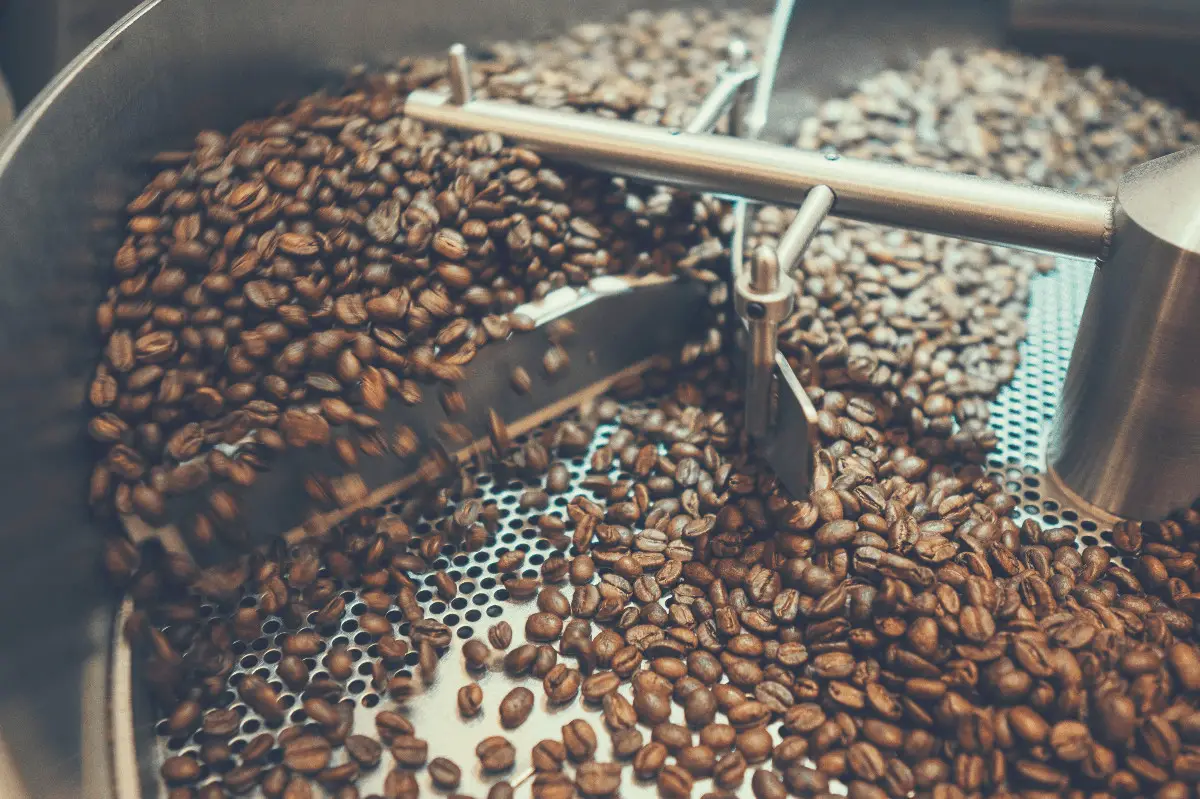Although the quality of a coffee bean goes a long way in determining the quality of your cuppa, the roast of that bean is at least equally important. Some say this is where the true magic happens. In this guide to coffee roasts, we’ll dive into the different roasting profiles and how they influence the taste of your brew.
Every young green coffee bean gets a true makeover before it ends up in our cup. The roasting process helps to transform that green and tasteless bean into an aromatic and flavorful version of itself.
What are the different kinds of roasts? How to distinguish them, and how does the roasting technique influence taste and aroma?
Why roast coffee beans?
During the roasting process, the coffee bean reveals its true inner self. It releases the aroma and flavor locked inside.
Apart from the origin of the bean, the harvesting, and the processing, the roasting process is the next most important thing in creating a great coffee.
Roasting is a constant process of tinkering and seeking perfection through small improvements. Some even go as far as to say that the roast can make or break a coffee, and we tend to agree.
Even fantastic beans can taste mediocre if not roasted right. On the other hand, average quality coffee beans can still surprise in flavor and acidity with a good roasting profile.
After the coffee bean grew for about 2 to 3 months, it’s harvesting time. Their natural color at this stage is green. They have a fresh, grassy smell and don’t have much taste. Basically, they have none of the characteristics of a roasted coffee bean.
Roasting is the process of rapidly heating the raw coffee bean. During the roasting process, chemical changes take place inside the bean.
Once they reach their ultimate roasting point, they are quickly cooled down. The result is a crunchy, darker bean that smells and tastes like the coffee we know.
After the roasting, the beans should be consumed or conserved as quickly as possible. This is because the freshly roasted flavor and aroma diminish quickly.

Who roasted the first bean and why?
For you history buffs out there, let’s dive into a quick lesson about how the coffee bean that we all know and love came to be.
After a little research, you will find several stories about the history of the coffee bean. Some are legendary and speak to our imagination.
The most accepted theory is about Sheikh Abu al-Hassan ash-Shadhili’s disciple, Omar. Omar was in exile from Mecca and hungry. He tried some berries from a nearby bush but found them to be bitter.
After trying to roast them over a fire, the taste got better, but now they were too hard and crunchy. In an attempt to soften them, he let them soak in boiling water.
The result was a fragrant brown liquid we know today as coffee. The drink revitalized Omar, and when the stories of his miracle drug reached Mecca, he was made into a saint.
The coffee plant has most likely originated from Ethiopia, Sudan, and Kenya. Back then, coffee was primarily consumed during religious practices in Islam
How coffee gets its taste
There are several factors that determine your coffee’s taste.
- Country of origin
- The blend
- The age of the coffee
- The processing method
- The grind
- The brewing method
Yet, the roast is instrumental in giving coffee its distinctive taste and aroma. It gives the buyer a rough guide on what to expect.
The most common way to distinguish between different roasts is to describe them based on the bean’s color (light to dark). The longer the roasting process, the darker the coffee bean.
Something as subjective as color is perhaps not a great way to determine the taste of the coffee. On the other hand, it still is a convenient way to categorize the level of roasting.
What are the differences in Coffee Roasts?
Roasting coffee is the process of adding heat to the fresh, green coffee beans. It gives the coffee bean its brown color. More importantly, the coffee bean undergoes a chemical process that defines the coffee’s taste and aroma.
Below are the main classifications but roasting beans is not as simple as ‘ticking them off’ into one of these classifications. The range in-between those grades is a sliding scale where a second or a few degrees can make or break the roast. The ‘art of roasting’ is to find that sweet spot and create something truly remarkable.
Light roasts
A light roast is achieved by roasting the beans at a relatively lower temperature. For this roast, the coffee bean reaches an internal temperature of 356-400℉ / 180-205℃.
During the roasting process, the beans crack and expand in size. This is known as “the first crack”. There are two cracks in total, more on that below. During the crack, the bean releases more taste.
The crack usually happens at 300-350℉ / 150-175℃. So, for a light roast, the beans have not been roasted until the first crack.

Characteristics of a light roast
- The coffee bean is relatively light in color.
- The taste of the coffee will be milder or mellow and has a ‘grainy’ taste.
- There is no oil on the surface of the bean.
- Light roasts have high acidity.
- Lightly roasted beans contain the most caffeine.
Medium Roasts
For a medium roast, the beans reach an internal temperature of 410-428℉ / 210-220℃. This is well past the first crack and just before the 2nd crack.

Characteristics of a medium roast
- The coffee bean has a medium brown color.
- The taste has more body than a lightly roasted bean.
- There is oil on the bean’s surface.
- It lacks the grainy taste of the light roast but balances flavor, aroma, and acidity.
- It contains less caffeine than a light roast but still more than a dark roast.
Medium-Dark Roasts
A medium-dark roast occurs at the beginning or just after the 2nd crack. The temperature of the bean is 437-451℉ / 225-232℃.

Characteristics of a medium-dark roast
- The coffee bean has a darker color.
- This bean has a heavy, spicy body and the aromas of the roasting process begin to become noticeable.
- Some oil may be present on the bean.
- The level of caffeine it contains is still lower as compared to the lighter roasts.
Dark Roasts
Dark roast occurs well after the 2nd crack at a temperature of 465-480℉ / 240-248℃.
Going beyond a dark roast would be at temperatures exceeding 490℉ / 255℃. At this stage, the bean becomes thin and fragile while tasting like tar or charcoal.

Characteristics of a dark roast
- The coffee bean is quite dark in color, almost black like pure chocolate.
- There is clearly oil visible on the surface of the bean. After brewing a dark roasted bean, a layer of oil can often be seen on top of the brewed coffee.
- The taste is generally more bitter, with a hint of caramel, smoky, or even burnt.
- The level of caffeine has substantially decreased.
What roast should you choose?
The roast determines the taste of your coffee to a great extent. Because taste is subjective, there is no hard and fast rule of what roast to choose.
Ultimately it’s a matter of taste and preference. We’re also not saying that coffee drinkers always prefer a certain roast over another.
Some roasts are better for espresso, while another roast might be better for a pour-over or drip coffee.
In the morning, you might prefer a cup that is more mellow in taste but has higher caffeine content. At night, after dinner, you might prefer something with a stronger taste and less caffeine.
Preference for a specific roast is often linked to geography. Europeans often favor darker roasts, which has led to French, Italian, or Spanish roast.
Even within the US, there is a clear difference. People on the East Coast prefer darker roasts instead of West Coasters, who typically prefer lighter roasts.
Italian Roast, Spanish Roast, Cinnamon Roast, French Roast, City Roast,…
Roast names, derived from the beans’ color (light, medium, dark), are a perfectly acceptable way to distinguish between roast types. However, they are not standardized across the business.
Therefore, it’s not always easy to determine the roast level just from the name.
Different roasters like to give different, sometimes proprietary, names to their roasts. For example, Starbucks will have special names for their own roasts.
Another common naming you will see is that roasts are named after the geographic location where they are from or where they are most popular. Examples of this are names like Spanish Roast, Italian Roast, or New Orleans Roast.
Finally, you may come across roast names derived from their dominant aroma, like Vanilla Blend, Cinnamon Roast, or Blonde Roast.
| Roast Type | Common Roast Names | Taste & Aroma | Caffeine Content |
|---|---|---|---|
| Light Roast |
|
|
|
| Medium Roast |
|
|
|
| Medium-Dark Roast |
|
|
|
| Dark Roast |
|
|
To help you out a bit, we’ve put some common names in the coffee roast chart below.

Conclusion
As with so many things when it comes to coffee, try and experiment and decide what you like.
Especially if you’re the kind of person who always buys the same roast because that’s the one you like, I challenge you. Visit a coffee house that sells whole beans, get some advice, taste a couple of different brews, and try new things!
Alternating between different roasts depending on the time of day or your coffee recipe gives your coffee drinking experience a whole new dimension.
What is your favorite roast, and why? We’d love to hear from you in the comments below.
Looking for a more detailed insight into the dynamics of the roasting process? Have a look at this video below.


